Better Sailing


Top Tips For Sailboat Racing
Most Cruising Sailboats are designed for comfortable sailing and living aboard. When informal racing becomes available, I find that some people pass on the opportunity because they feel their boat might not be suitable for competition. By using the following 13 ideas, sailors who occasionally enjoy racing can improve their performance and have more fun on the water.
Preparation before the race is time well spent. Read the sailing instructions carefully to understand the schedule, racecourse, and rules of the regatta. Next, recruit the correct number of crew for your boat. Sailing with too many or too few people makes it harder to perform efficiently. Next, study the weather so your team will have the correct clothing, set the most appropriate sails, and feel comfortable with the conditions you will sail in. Keep the boat light. Take off any items that you will not need for the race. Too much gear will slow the boat down. This may take a little time, but the boat will sail faster, and the extra room will make it easier for the crew to handle the sails and move around.
Before the race, hold a crew meeting. During this session, assign each member of the crew a specific job to do during key moments of the race, such as the start, rounding marks, changing sails, or maneuvering. This is the time to discuss the weather forecast, explain the racecourse, and set your goal for the day. Head out to the course at least one hour before the race. From the moment you leave the harbor, take the attitude that you are racing.
Sailboat Racing Start Tactics
Practice at least two starts. I like to try one practice start at each end of the line. Make a note of which end of the line seems to be favored (closer to the first mark of the course). Next, study the course to determine which side might have more wind. The best way to do this is to look at other boats. Ask yourself which boats appear to be heeling more or sailing faster. Every member of the crew should work in his or her pre-assigned area during practice. When you make the final approach to the starting line, avoid getting locked up with another boat.
Your goal is to start with full speed and clear wind. This is easier if you can start cleanly. Accelerate up to full speed at least 10 seconds before the gun. Most cruising boats are relatively heavy and take time to reach full speed. Ask one crew member to take bearings as you approach the line. You should be within one-half a boat length of the line at the start.
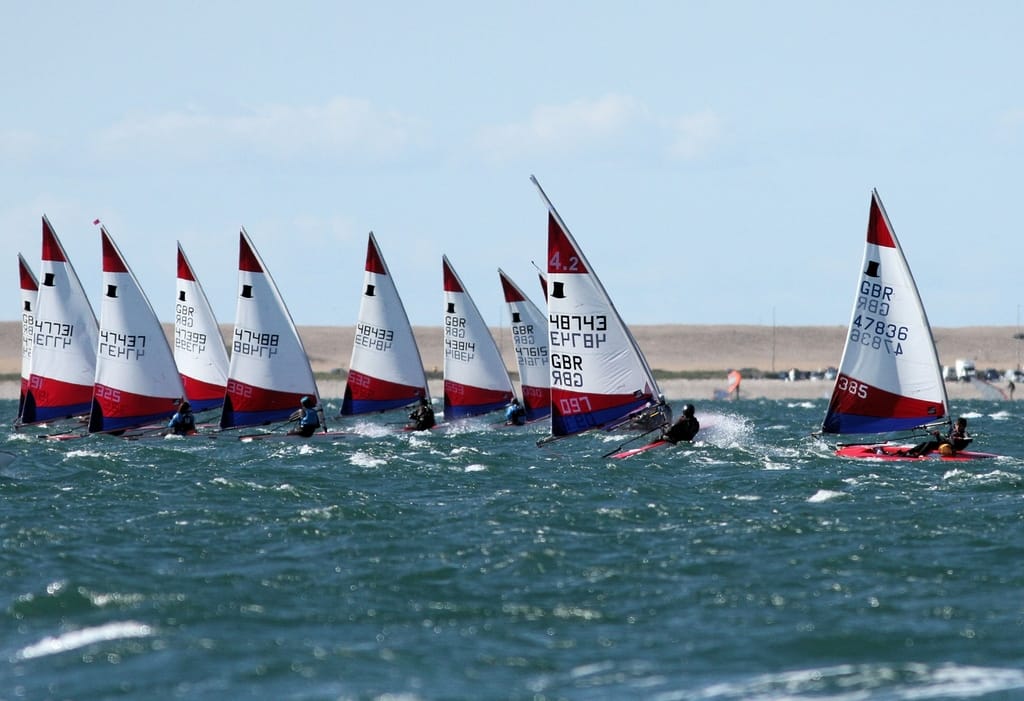
On the first leg, stay on the same course for two minutes or longer before making the first maneuver. When you prepare to tack, make sure the entire crew is ready. Watch carefully to make sure you will be sailing in the clear wind (clear of other boats) after the turn. If you think your boat is gaining by sailing straight ahead, keep going. If your side of the course seems to be losing distance to other boats, then you should consider switching sides of the course. Only tack when you have a reason; a big mistake many tacticians make is tacking too often.
Constantly study the wind. When reading the wind, wear polarized sunglasses to help cut the glare and make seeing the wind ripples easier. Use all available indicators to see what the wind is doing. This includes the course other boats are steering or how far they are heeling over, fags onshore, smoke from stacks, and the angle of anchored boats.
Maneuvering:
All boats lose considerable distance while tacking or jibing. Prepare your crew well in advance of any turn. But be careful not to shout too loudly; you don’t want the competition to know when you are about to tack. Sail at full speed before making your turn. Never turn the boat faster than the crew can trim the sails onto the new side. A tack should be broken up into three stages: the first third of a tack or jibe should be slow. The harder you turn the rudder, the more the boat will slow down.
The second part of the turn should be faster. This is when the wind is straight ahead during a tack and straight behind during a jibe. The last part of the turn should be slower while the sails full and your boat accelerates. Look at the course you have steered by studying the water behind your boat. If the shape of the turbulence in the water resembles the shape of a question mark, it is an indication that you have turned the boat too quickly.
Skippers gain popularity with crews by allowing several people to steer during a race. While at the helm, concentrate on just steering. Use every source of information available. This list includes the speed and wind instruments, the angle of the heel of the boat, and the telltales flowing from the sails. If a big gust of wind is approaching, prepare to sail a higher course to keep the boat from heeling too much. Tell your mainsail trimmer to prepare to drop the traveler to leeward or ease the sheet out. Overheeling makes a boat go sidewise and lose speed.
The most skilled helmsmen work to keep their boats sailing fast by avoiding sailing a course that is too close to the wind and, therefore, slow. The best way to determine if you’re sailing efficiently is by studying your boat’s speed compared to the competition’s. This is the job of the tactician. Use a hand bearing compass to tell if you are gaining or losing bearing to another boat.
Trim your sails to perfection. The maximum draft of all sails should be about 40 percent of the way aft of the leading edge. Sight up the mainsail’s boom — the top batten should be parallel to the boom. Try to set the leech of the jib to be in line with the curvature of the mainsail. If the jib is lufng at the top before the bottom, move the jib lead forward. If the jib is lufng at the bottom of the sail first, move the jib lead aft. Your goal is to have the telltales all lufng at the same time. If you fly a spinnaker, set the pole so that it’s perpendicular to the mast. Raise or lower the spinnaker pole, so the bottom corners (the clews) of the sail are in line with the horizon.
If the boat is heeling too much, fatten the shape of the main and jib. Anytime you take tension in a sail, the draft will move in that direction. If your boat is sailing in light wind and you’re sailing slowly, ease the sheet, downhaul, and halyard to give the sail a more curved shape. One crew should constantly trim the mainsail while another crew trims the jib or spinnaker. The helmsman and the trimmers should talk to each other. If the helmsman is heeling too much, he should ask to reduce the power in the sails by easing them out or fattening out the draft in the sail.

Know the Basic Racing Rules
The rules are complex and require years of practice or study to understand all the subtle nuances. But the fundamental rules are designed to keep boats from having collisions. If you’re on a starboard tack, your boat has the right-of-way. If you’re too leeward, your boat has the right-of-way. An overtaking boat must stay clear of a boat ahead. An inside boat approaching a turning mark is entitled to room to pass the mark. If you must alter course to stay Hands-On sailOr clear of a right-of-way boat, it helps to hail the other boat that you are changing course. The rules are based on common sense.
Sail in Clear Wind
The wind shadow of boats can extend as far as 10 boat lengths. Avoid sailing in the exhaust of another boat. Note the position of your masthead. If it points at another boat —whether on a windward leg or a leeward leg — the other boat is likely giving you disturbed wind. Your options are to tack or jibe away or sail a different course until your wind is clear.
Communications:
On every vessel there is one person in charge. All information must be funneled to the skipper. This is the person who will make the final decisions. Input from the crew is always helpful. The tactician should note a boat’s progress, making the calls relative to your boat; for example, “We are sailing 5 degrees higher.” I have been on boats where a skipper will yell more and more about less and less. Screaming is no fun. A calm, steady voice will give the crew confidence that the correct calls are being made. When you are giving commands, speak in the direction of the crew so they can hear you, use as few words as possible, and explain things in precise terms. For example, ask to ease the jib 4 inches or head up 5 degrees. avoid making vague, confusing comments such as “ease the jib a touch.”
Keeping a crew happy is important. Everyone is on board to have a good time. As mentioned, yelling must be avoided at all costs. The tactician can build morale by forecasting what will happen in advance. An example might be, “We are going to tack in eight boat lengths. after the tack, we are going to sail five degrees low, of course, to gain speed for a bad set of waves that are approaching from a powerboat.” issuing team shirts or hats build team spirit. A well-fed crew is always happy. Be sure everyone is wearing the correct clothing, uses sunscreen, and most importantly, wears good shoes or boots. I have seen many injuries happen to barefoot sailors. When something goes well, be sure to compliment everyone.
Racing Philosophy:
Level of sailing, work to keep a good average score throughout a multiple-race regatta. Avoid taking big chances or splitting away from the fleet. One of the biggest mistakes is to get into a battle with just one other boat while allowing the rest of the fleet to sail away. When the wind is light, the skipper and crew need to be patient. Every member of the crew should be encouraged to add suggestions. The key is when to give advice. as a skipper, I like to ask questions about where the best wind seems to be or what actions other boats are taking. Don’t get too excited when you are in the lead and don’t get too upset when things go wrong. When behind, I tell my crew, “Just for fun, let’s see how much ground we can make up.”

Little Things Can Make a Big Difference
Many small adjustments add up. Keep your crew in the middle of the boat fore and aft. in light wind, move the crew to leeward. When the wind comes up and the boat heels over, move the crew to the windward side. During a race, I ask the crew to move frequently as the wind velocity changes. Watch the other boats. If you observe something going well on a competitor’s boat, use the idea.
After the Race
Afterward, take the time to have another crew meeting to discuss what went well and what can be done better for the next race. Make a list. If any equipment is broken or didn’t work well, get it fixed before the next race. Clean the boat up, fold sails, put the covers on, and put everything in its proper place before breaking out the snacks and drinks. Every member of the crew should participate. If your boat didn’t win, be sure to congratulate the winner. They will return the favor when things go your way. Always attend some part of the post-race festivities. The hosts appreciate your attendance. Finally, be sure to schedule your next race and invite the crew for another good time on the water.
Peter is the editor of Better Sailing. He has sailed for countless hours and has maintained his own boats and sailboats for years. After years of trial and error, he decided to start this website to share the knowledge.
Related Posts

Atlantic vs Pacific: Which is More Dangerous for Sailing?

Why Do Sailboats Lean?

How Does a Boat Sail Upwind? Unveiling the Mechanics of Against the Wind Sailing

How Does Sailing Work? The Physics of Sailing
- Buyer's Guide
- Destinations
- Maintenance
- Sailing Info
Hit enter to search or ESC to close.

Boat Sailor
Sailboat racing: a passionate enthusiast’s guide.
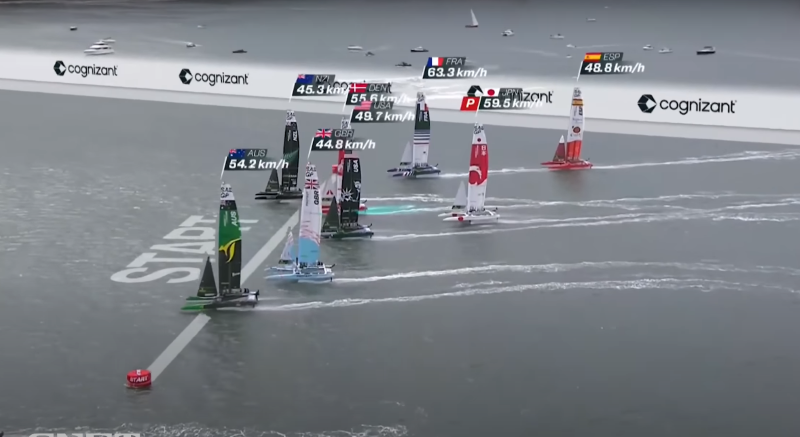
Ahoy there, fellow sailing enthusiasts! If you’re reading this, you’re probably either a seasoned sailor looking for tips to up your sailboat racing game or a curious novice eager to dive into the exhilarating world of sailboat racing. Well, you’re in for a treat! In this article, I’ll share my insights and advice on sailboat racing, offering helpful suggestions and reasons behind them.
Introduction to SailBoat Racing
Sailboat racing is not just a sport; it’s a thrilling adventure that combines the beauty of sailing with the excitement of competition. Whether you’re racing on a serene lake, a choppy sea, or a picturesque coastal route, the rush of the wind in your sails and the camaraderie among fellow racers are truly unmatched.
Choosing the Right Sailboat
Before you hit the waves, you must choose the right sailboat for your racing endeavors. Factors like boat size, design, and materials play a crucial role in determining your racing performance.
Factors to Consider
Consider factors such as boat size, hull shape, keel type, and sail plan. These elements directly influence your boat’s speed, stability, and maneuverability on the water.
Essential Gear and Equipment
To ensure your safety and comfort during sailboat racing, you’ll need the right gear and equipment.
Sailing Apparel and Safety Gear

Sailboat Rigging and Setup
Properly rigging and setting up your sailboat is essential for optimal performance on the racecourse.
Setting Up Your Sailboat
Learn how to rig your sails, adjust your rigging, and fine-tune your boat’s settings to maximize speed and control in different wind conditions.
Understanding Wind and Weather
A deep understanding of wind patterns and weather conditions is crucial for successful sailboat racing.
Reading Wind Patterns
Learn to read wind patterns, such as shifts, gusts, and lulls, to navigate the course efficiently and gain a competitive edge.
Sailing Techniques and Strategies
Mastering various sailing techniques and strategies is key to becoming a successful sailboat racer.
Upwind and Downwind Sailing
Explore the nuances of upwind and downwind sailing, including tacking, jibing , and sail trim techniques, to outmaneuver your competitors.
Racing Rules and Etiquette
To maintain fairness and safety on the water, it’s essential to familiarize yourself with racing rules and etiquette.
Understand rules related to right of way, mark rounding, and protest procedures to ensure fair competition and avoid penalties.
Training and Skill Development
Continuous training and skill development are vital to improving your sailboat racing prowess.
Improving Your Sailing Skills
Invest time in practicing maneuvers, refining your sailing techniques, and honing your racing strategies to stay ahead of the pack.
Joining a Sailing Club or Team
Consider joining a sailing club or team to connect with fellow enthusiasts and gain access to valuable resources.
Benefits of Sailing Communities
Sailing communities offer support, mentorship, and opportunities to participate in organized races and regattas.
Preparing for Your First Race
Your first sailboat race can be nerve-wracking, but with the right mental and physical preparation, you’ll be ready to tackle the challenge.
Mental and Physical Preparation
Stay calm under pressure, focus on your goals, and maintain physical fitness to excel on race day.
Race Day Tips and Strategies
On the day of the race, employing effective tips and strategies can make all the difference.
Staying Competitive and Safe
Learn how to make tactical decisions, adapt to changing conditions, and prioritize safety throughout the race.
Common Challenges
Sailboat racing isn’t without its challenges. Prepare yourself to face adverse conditions and unexpected situations.
Dealing with Adverse Conditions
Discover strategies for handling strong winds, unpredictable currents, and equipment failures gracefully.
Celebrating Your Victories
As you progress in sailboat racing, don’t forget to celebrate your achievements and the joy of being part of this incredible sport.
Enjoying the Sport and Achievements
Share your experiences with fellow sailors, savor the camaraderie, and bask in the thrill of the racecourse.
Safety Precautions and Emergency Protocols
Prioritize safety at all times by following proper safety precautions and emergency protocols.
Staying Safe on the Water
Know what to do in case of emergencies, from man overboard drills to calling for assistance.
In conclusion, sailboat racing is a thrilling pursuit that combines the joys of sailing with the excitement of competition. Whether you’re a novice or a seasoned sailor, following these tips and strategies will enhance your racing experience. So, hoist your sails, embrace the wind, and embark on an unforgettable journey of sailboat racing!
What is sailboat racing?
It is a competitive sport where sailors race against each other to complete a designated course using sailboats.
What type of sailboat is best for racing?
The best sailboat for racing depends on various factors, including boat size, design, and materials. It’s essential to choose a boat that suits your racing goals and experience level.
How can I improve my sailboat racing skills?
Improving your racing skills requires practice, training, and a deep understanding of sailing techniques and strategies. Joining a sailing club or team can also help you progress.
Are there any safety precautions for sailboat racing?
Yes, safety is paramount in sailboat racing. It’s crucial to wear appropriate safety gear, know emergency protocols, and be prepared for adverse weather conditions.
Can beginners participate in sailboat races?
Yes, beginners can participate in sail

Michael Thompson
Embarking on a lifelong love affair with the sea, I found solace and exhilaration in the art of sailing. From navigating treacherous waters to harnessing the wind's untamed power, my passion has evolved into a mission to inspire others. Join me on a voyage of discovery as we explore the vast horizons of sailing's timeless allure.
More to Explore

Sail Boat Trailers: Your Guide to Safe and Convenient Transportation

Sail Boat Decor: Enhancing Your Nautical Oasis
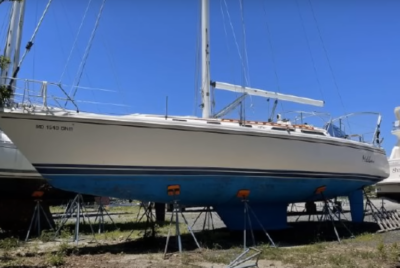
Keel Sailing Boat: Navigating the Seas with Stability
- Yachting World
- Digital Edition

5 tips: sailing to win. Top match racer Ian Williams gives his top tips
- January 21, 2015
Sailing to win – how to win a race and ensure you cross the line first. Tips by top match racer Ian Williams

Although the start line of a competitive fleet can be an adrenalin-fuelled arena, with well-versed crews showing off their prowess, the end of a race can be just as tough. Energy levels may be running low, concentration might slip, but the final leg of the race may provide a perfect opportunity to snatch a result.
Capping a good race begins with knowing the basics and taking nothing for granted. For example, finishes at a fixed mark may not specify a side, only that you must pass between a particular buoy and the race committee finish boat. So being alert is vital, particularly if other craft in the area of the finish line are confusing the scene.
Positive thinking, clear tactics and concentration are critical. Assuming you’re not in a head-to-head finish line showdown with one-design rivals, sailors in handicap fleets can keep crew morale high by minimising the time lost and by maximising the chances of success when the corrected times are displayed.
1. Make sure you know the course and where the finish line is located. The finish is normally defined in the Sailing Instructions, but is often not very well-described when the race committee reads out the course. Make sure you know how to identify the finish line and have noted any peculiarities in the SIs, particularly which is your finish if there are multiple finish lines.
2. This is hard to judge as you approach, so try to get a bearing when you pass the finish line during the race. If that is not possible, consider approaching the finish in a way that allows you to make a late decision about which end to go for – tacking for the line as soon as you can lay it will help to leave your options open.
3. Decide what your tactics on the final leg to the finish need to be. It is important to know what you have to achieve. If you are handicap racing, you should assess which boats you are close to on corrected time and what you need to do to beat them. In level rating racing, consider whether you are attacking or defending, or you may be clear enough of other boats to start preparing for the next race.
4. Remember RRS 18 (Mark-Room) applies at the finish (unlike at the start), so a boat inside at a finish mark or boat is entitled to room. The rules also apply until any boats involved in an incident have cleared the line, so in close situations make sure you have done so before relaxing. Rules 28.1 (Sailing the Course) and 31 (Touching a Mark) are worth keeping in mind too; the latter would require a single penalty turn and a re-finish unless specified differently in the Sailing Instructions.
5. In close races, vital seconds can be gained by luffing head to wind (or dialling down on a downwind finish) right at the finish line. Upwind you close the line at about 1.3 times faster head to wind than you do sailing at 40° true, so as long as you do not drop below about three-quarters of your upwind speed, you will be gaining time.
Ian Williams is a four-times ISAF Match Racing World Champion and the only European to hold multiple match racing world titles. He has won the World Match Racing Tour ten times. Williams is also well-known on the professional big boat circuit as a tactician, having won regattas in many different classes and has been shortlisted twice for the ISAF World Sailor of the Year award and twice for the British Yachtsman of the Year award
This is an extract from a feature in Yachting World July 2014

- Find A School
- Certifications
- North U Sail Trim
- Inside Sailing with Peter Isler
- Docking Made Easy
- Study Quizzes
- Bite-sized Lessons
- Fun Quizzes
- Sailing Challenge

Mastering Sailboat Racing Tactics: A Winning Approach
By: Zeke Quezada, ASA Sailing Races
Sailboat racing demands a unique blend of skills and expertise. The dynamic nature of racing, with its ever-changing winds and currents, requires sailors to excel in various aspects to secure victory. One of the biggest challenges is dealing with the fluid playing field upon which we play. At North U, experts understand that sailboat racing success is built on a pyramid comprising Boat Handling, Boat Speed, and Tactics, with Tactics reigning supreme at the pinnacle.
Building the Foundation: Boat Handling and Boat Speed
Before delving into the intricacies of racing tactics, it’s crucial to lay a solid foundation. Boat Handling forms the base of the pyramid, emphasizing the importance of mastering the art of sailing. Without proficient boat handling skills, even the best tactics would falter. Next in line is Boat Speed, a universal requirement across all forms of racing. Whether it’s bicycles, bobsleds, or sailboats, speed is the essence of victory in any race.

Reaching the Summit: Racing Tactics
Atop the Racing Pyramid stands Tactics, the ultimate decider in the world of sailboat racing. Once you’ve honed your boat handling and achieved exceptional speed, mastering tactics becomes the key to clinching victories. Tactics, in its broadest sense, encompasses Strategy and Tactical execution, each playing a pivotal role in the race.

Understanding Strategy and Tactics
Strategy is the overarching plan that revolves around wind, wind shifts, and current. It is an overall gameplan detailing how a sailor would navigate the course independently while factoring in the complex interplay of natural elements. On the other hand, Tactics involve the practical implementation of the strategy and the adept handling of other boats in the race. Understanding and adhering to Racing Rules are part of Tactics, as the rules dictate your rights and obligations as you deal with other boats.
General Tactical Tips:
- Craft a Comprehensive Strategy: Formulate a game plan based on your expectations of the wind’s behavior. A well-thought-out strategy provides a roadmap for your race.
- Get a Good Start: While a perfect start is ideal, it’s not mandatory for victory. Focus on launching at full speed from the starting line, ensuring you have clear air near the favored end. A strong start sets the tone for the race.
- Chase the Wind: Seek out areas with more wind and navigate your boat towards these pockets. Sailing in favorable wind conditions gives you a significant advantage over competitors.
- Embrace Speed: Sailing at maximum speed is a game-changer. Position your boat in a way that allows you to maintain top speed throughout the race. Sometimes, the simplest strategy is the most effective.
- Master the Shifts: Tacking and jibing strategically based on wind shifts is crucial. Upwind, tack when you’re headed away from the mark and sail on the lifts that push you towards it. Downwind, jibe when lifted away from the mark and sail on the headers, guiding you in the right direction.
Sailboat racing tactics are the culmination of strategic planning, meticulous execution, and adaptability to the ever-changing elements. By mastering the art of strategy and tactical maneuvers, sailors can elevate their racing performance.
Ready to Become a Master?
Choose from among American Sailing’s many resources to help you improve your racing — from online courses, to textbooks, to week-long events, you can choose one or all to upgrade your sailing racing skills.
Online Classes
Learn more about how to form winning racing strategies at the Racing Strategy, Tactics and Rules Online Class. This 4-session series hosted by Bill Gladstone starts October 17, 2023.

The most complete books on modern racing tactics and trim, North U takes you all the way around the course. These textbooks are an essential part of any racing sailors library.

Performance Race Week
At American Sailing Performance Race Weeks powered by North U, we spend five days exploring every facet of racing success through an enriching blend of practical on-water training and races complemented by shoreside seminars and insightful video reviews. With a coach on every boat, you’ll receive close personal attention to build on your strengths and eliminate your weaknesses. Join us for this unique opportunity to become a better, more versatile, and more accomplished sailor.

Related Posts:

- Learn To Sail
- Mobile Apps
- Online Courses
- Upcoming Courses
- Sailor Resources
- ASA Log Book
- Bite Sized Lessons
- Knots Made Easy
- Catamaran Challenge
- Sailing Vacations
- Sailing Cruises
- Charter Resources
- International Proficiency Certificate
- Find A Charter
- All Articles
- Sailing Tips
- Sailing Terms
- Destinations
- Environmental
- Initiatives
- Instructor Resources
- Become An Instructor
- Become An ASA School
- Member / Instructor Login
- Affiliate Login

Sailboat Racing Tips: Speed Through Kindness
Where Kindness May Be Your Most Strategic Sailboat Racing Strategy
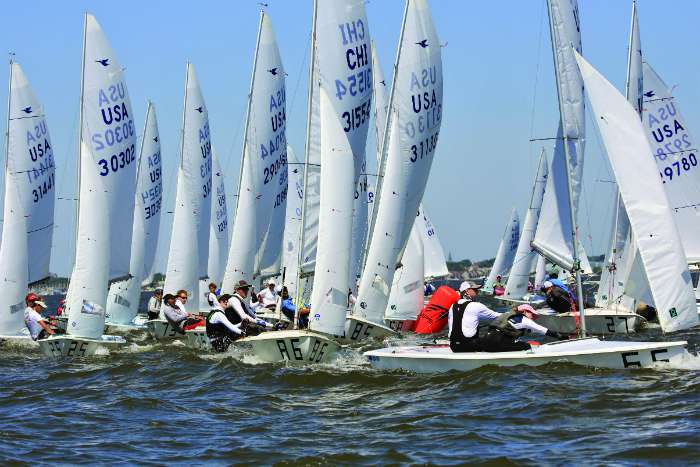
by Kim Couranz – published on SpinSheet
The overall objective in sailboat racing is to cross the finish line first—to sail the course faster than your competitors. While there are endless decisions to make toward achieving that goal, simply sailing fast is a (and sometimes, the) primary key to success.
Sailboat racing is also supposed to be fun. Being tangled up with other boats, or being distracted by what’s going on around you, isn’t fun or fast.
What does “tangled up” mean here? It can be literal or figurative; from getting your shrouds meshed with another boat to a little bumper boat action to getting yourself in bad air, tangled is slow. Distractions are slow, whether it’s something that draws your focus away from driving fast or if it’s thinking about how you’re going to write up that protest form from the situation that just happened.
You can often avoid getting tangled up or distracted by being kind to your competitors. There are a few spots on the racecourse where the benefits of being kind to other boats can pay off not only for them but for you as well.
Before, during, and just after your start is a critical time where you need to focus on getting your boat off the line. It’s not where you are right at the start but 30 seconds after the start! Are you able to start with fairly clean air and a lane you can keep going in for a bit? That’s the goal. Yes, sometimes when you’re on final approach to the line, you need to do a bit of squeezing in to get your spot. But rarely do you need to screw someone else to do that. Swooping in from up the line or tacking super tight to leeward of a boat already set up on starboard makes them alter course and also restricts your maneuverability.
Remember Racing Rules of Sailing #16, which notes that a right-of-way boat must give the other boat room to keep clear—so that if you come in to a starting line too close to leeward to another boat, and as they pivot and try to head up to keep clear of you, the back hip of their boat hits your windward side, there’s a good chance you didn’t give them enough room. And then, they are possibly on your air (not good for you getting rolling fast as the starting gun fires), and you may have some time in the protest room ahead of you (a short- and long-term distraction). The alternative? Be a little kind, give them a little more room, and everyone’s happy.
Mark roundings are another classic part of the racecourse where kindness can help you get around the course more quickly. Coming in near the weather mark on port tack, there’s a starboard tack boat you could either cross or plant a tight lee bow on, maybe on layline but maybe not? Crossing them and tacking above them not only lets them keep on trucking, but also means you don’t have to pinch (= slow) your way to the weather mark. True, they might round the weather mark before you, but you’ll be tight on their tail and on their breeze, ready to pass them downwind.

- Kim Couranz
Leave a reply
Your email address will not be published. Your comment will be revised by the site if needed.

Semana Internacional del Yachting
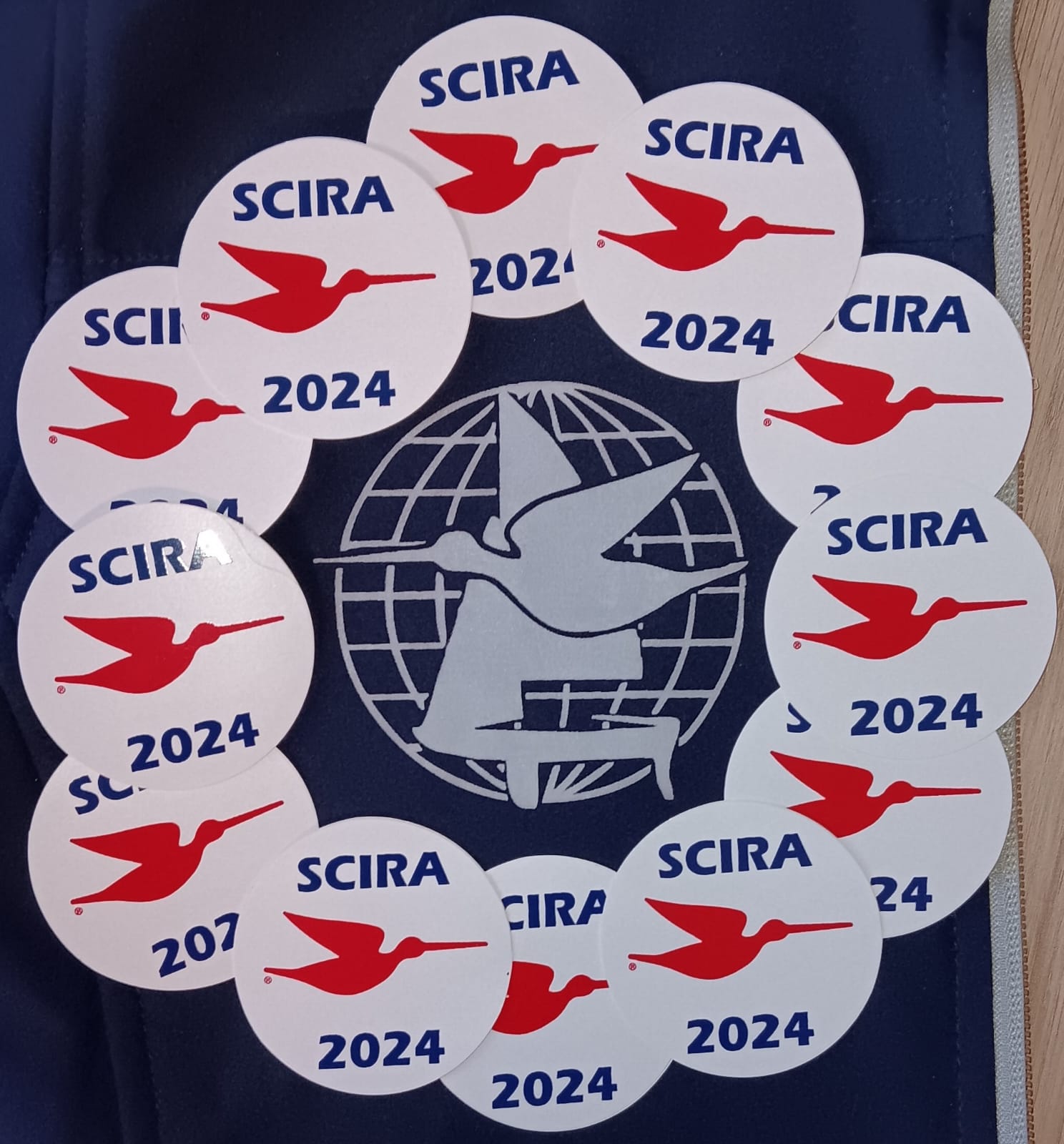
2024 SCIRA Decals
More content
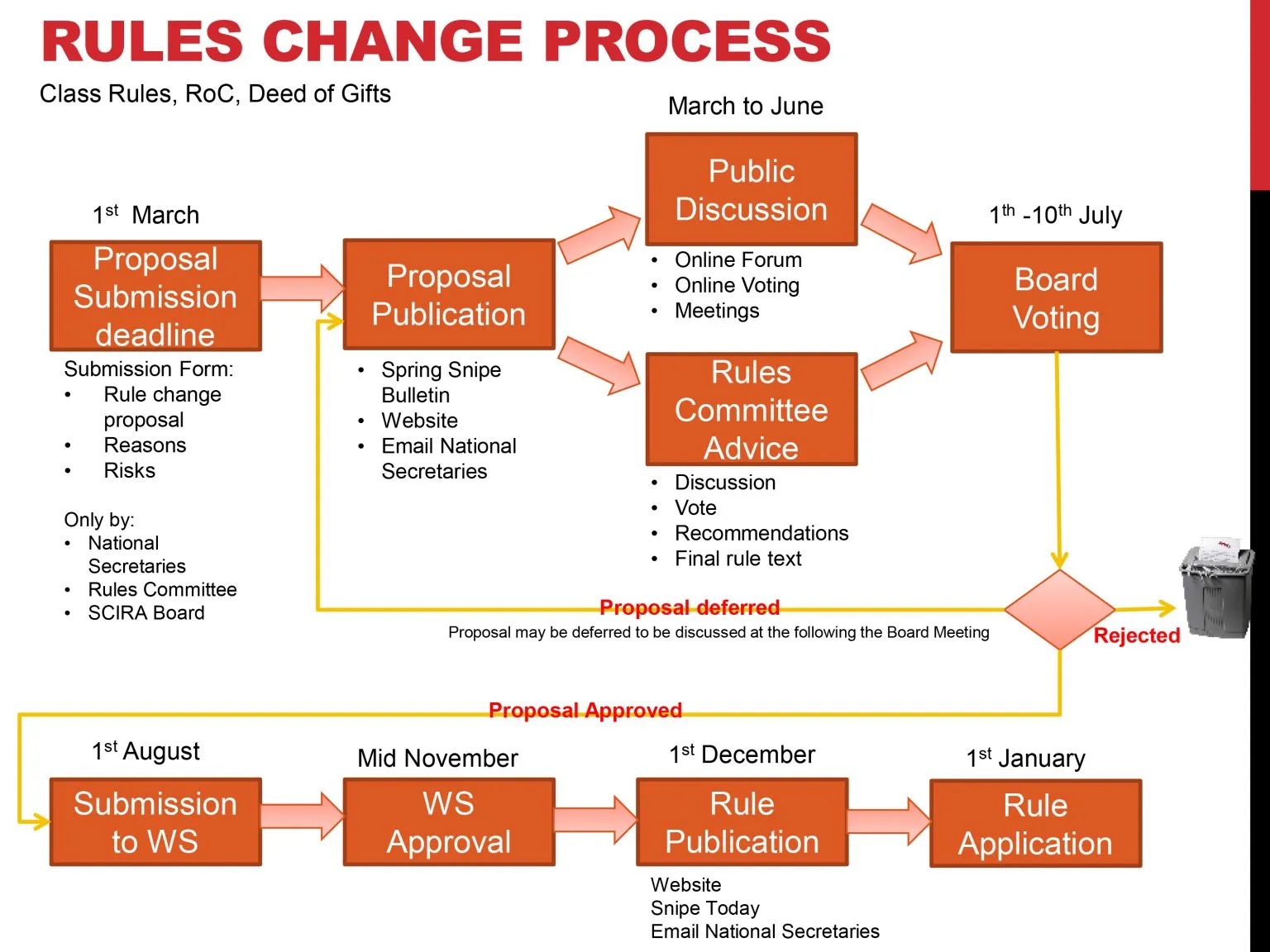
Rules Changes: Submitted Proposals
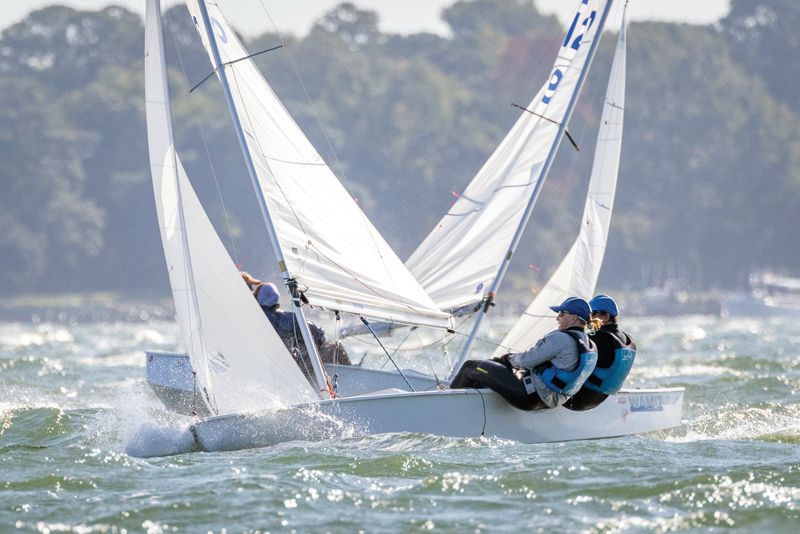
There’s More Than One Reason for Having a Game Plan at a Regatta

SnipeToday Video Conference: Regatta Preparation
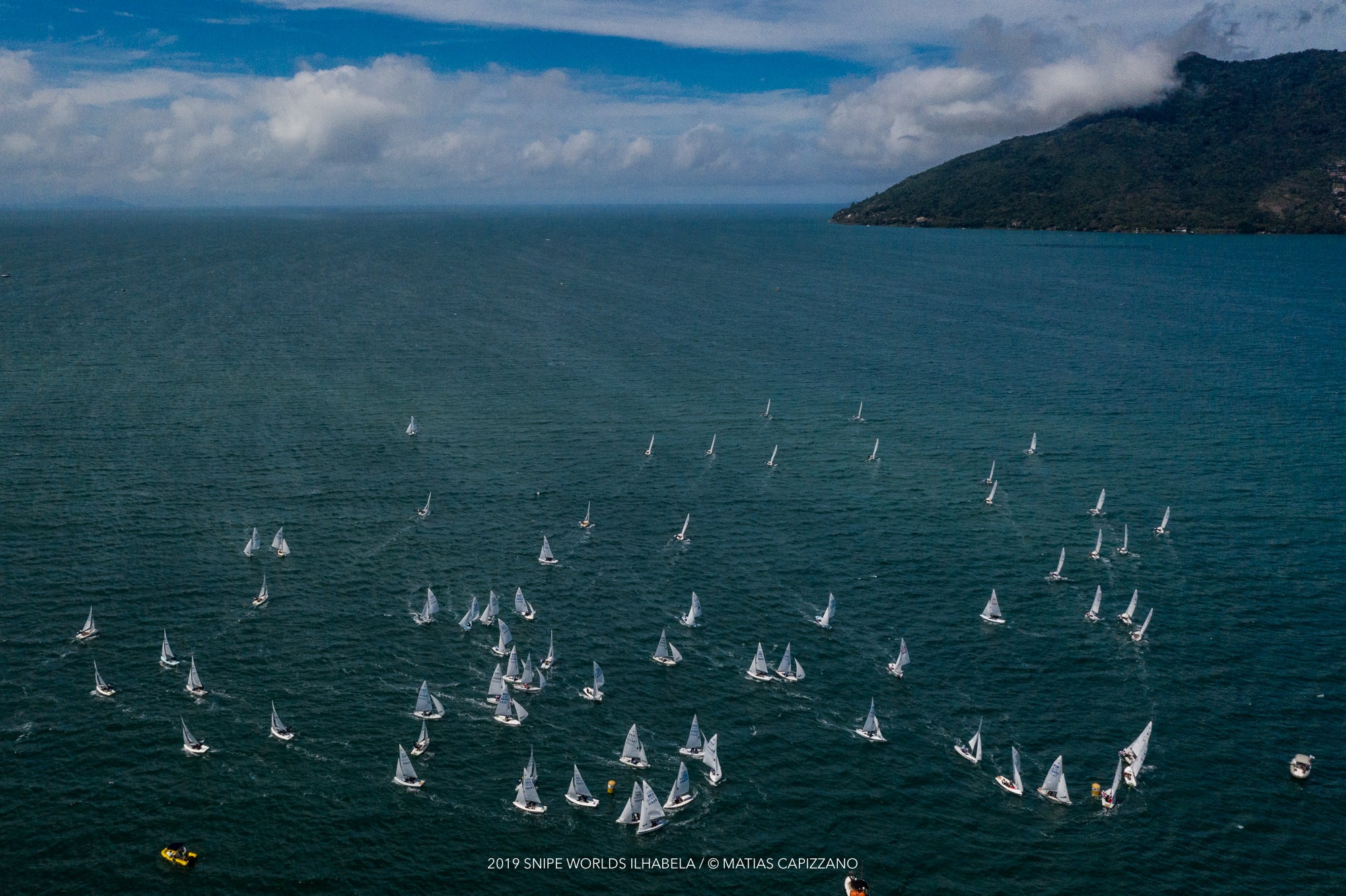
Choosing the “Right” Gate: My Top Ten Factors
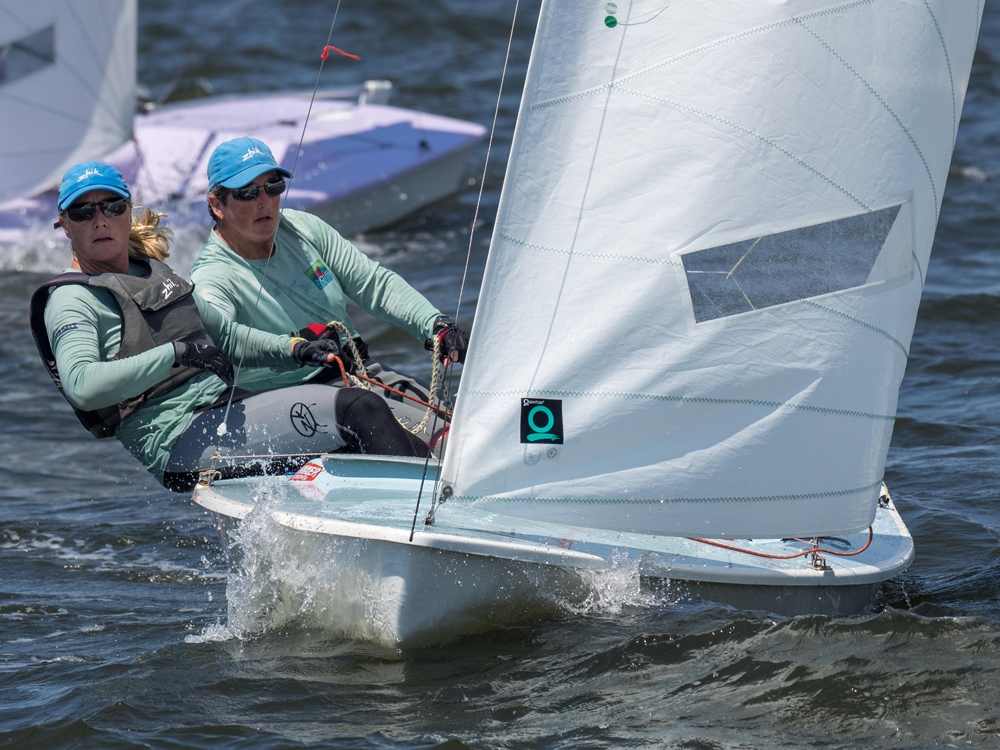
Listen To Your Teammate
Race Compass Smarts: When and How to Use One

Get a race compass! Without a compass, it seems there is a herd mentality, a tendency to go with the crowd. With a compass you’ll know why you are going with the crowd, or not. Sailboat Racing with Gr eg Fisher
Until you’re pretty experienced and sailing against really good people, just sail in pressure on the tack that is closest to the mark. You’ll do well and don’t need a race compass. “Surf Nazi,” on Sailing Anarchy
In my opinion the compass is a secondary input. A compass only provides information for one spot on the course. More important to look around and read the wind patterns by checking the heading of boats around the course. “Dog,” on Sailing Anarchy
Since acquiring a compass several years ago, I have experienced the yin and yang expressed in the three statements above. The compass has helped me in many ways, but being too reliant on it has also hurt me. For this post, I collected the existing wisdom on the pros, cons, and techniques for using a race compass.
We have updated this post from the original version with new tips, mental math examples, and refreshed links to compass sources. Unfortunately, our favorite digital compass, the Velocitek Shift is no longer in production.
Pros and Cons of Using a Race Compass
You win sailboat races by sailing faster and less distance than your opponents. To sail less distance, you must have a good feel for the angles. Many sailors develop this feel visually over time. However, not everyone can retain this visual information in the heat of battle.
Pro: precise angles matter
A compass gives you a precise tool for the angles. Winning in One-Designs , by Dave Perry, has a great table showing the dramatic gains and losses due to wind shifts in various situations, even with small shifts. A 5° shift results gives the favored side an advantage of 12% of the lateral separation. On a 200-yard starting line, that’s a 24-yard advantage. If you sail a 5° header for one minute you will lose at least four boat lengths to a boat on the lifted tack. For a simple table of advantages, check out this article from Sailing Breezes .
Pro: quick reference tool with many uses
In the heat of battle it’s nice to simplify your life. A compass gives you a quick reference for decisions in the stressful moments, such as after starts and mark roundings. A compass helps you find marks, check the starting line, and sail the lifted tack.
Con: distraction of dubious value
Many seasoned sailors say that using a race compass is just one more excuse to keep your head in the boat. You should be looking around constantly, integrating all the data about sailing angles, wind strength, and competitors. You can train yourself to recognize slight headers and store a mental picture of the average wind direction in your head. When a permanent shift occurs, your previous compass data on average wind is useless.
The verdict
I’ll go with Greg Fisher on this one: use a compass, but learn to use it as one input, and keep your head out of the boat. This is what we should strive for. The compass has helped me even on small lakes. As the lake gets bigger, a compass becomes more important, since there are fewer shore references.
Using a Race Compass: The Numbers
So, you’ve decided to try using a race compass. To use it effectively, you need to “know the numbers.” Use part of your pre-race routine to gather the data and do the math.
Average headings and wind direction
- Sail on each tack for at least ten minutes. The more time and more portions of the course, the better. Write down or mentally note your headings on each tack. Caution: when noting a heading, make sure you are trimmed in and sailing a true close-hauled course. If you are pinching or footing, your numbers won’t be accurate.
- Determine the average heading on each tack, and the highest and lowest values as well. Record or remember these numbers.
- Determine the average wind direction. This is the value halfway between the average heading on each tack. Example: 235° average on port, 145° average on starboard. Average wind is 190°. (235-145 = 90. 1/2 of 90 = 45. 45 + 145 = 190)
- Check the average wind direction against other known quantities: -Go head to wind several times and compare the compass bearing to your calculated average wind. -Check the calculated average wind against the RC radio chatter or posted course bearing. -Check the average wind against the forecasted direction.
- Keep checking the average wind to detect any oscillations or persistent shifts that may be occurring before the start.
Tacking angle
Your tacking angle is the difference of the average readings on each tack. In the example above, the tacking angle is 90°. This is a common tacking angle in medium breeze. Tacking angles might range from 80° in slightly heavier air to as much as 100-110° in light air. As your tacking angle changes, it will affect your average headings on each tack. It’s very important to know your tacking angle in various wind ranges, even if you don’t use a compass.
Starting line bias
With shifty winds, any momentary advantage at one end of the line disappears when the wind shifts. The best strategy is to know the line bias to the average wind direction. Race Committees try to set the line square to the average wind, but they often fail.
Don’t use the windward mark placement to determine the average wind. Race committees don’t often center the windward mark on the course. See our post on ladder rungs for more about why windward mark placement doesn’t matter.
Finding line bias
Sail down the line in either direction, lining up bow and stern with the line flags or buoys. Compare the bearing to a square line. A square line will be the average wind minus 90° when sailing on starboard, or the average wind plus 90° when sailing on port. Example: Your compass bearing when sailing the line on starboard toward the pin is 85°. The average wind is 190°. These figures give you the following insights:
- A square line bearing on starboard tack would be 190 – 90 = 100°
- The 85° bearing on starboard indicates the pin (left) end is 15° low (100 – 85).
Anything more than a 5° bias may be significant, especially if the line is long.
Memory and visualization aids for line bias
- Square line bearing on port equals the average wind plus 90 (p is for port and plus). Starboard is minus 90.
- When sailing the actual line on starboard tack, if heading is higher than the square line bearing, the left-hand side of the line is favored. If heading is lower , the right-hand side is favored. ( SLR – starboard-lower-right).
- A quick way to check this without math is to sail from one end of the line at the heading you determined for the square line. Then see which end of the line is low. This doesn’t give you the actual line bearing, but may be all you need to know.
Mental math examples to try
Here are some examples. Try to do these in your head and fill in the blanks.
- Average upwind headings: starboard tack – 060°; port tack – 140°
- Average wind direction: ________
- Tacking angle: ________
- Square line bearing on port: ________
- Square line bearing on starboard: ________
- Favored end (right or left): ________
- Degrees favored: ________
Click here for answer.
- Average wind direction: 330° (You weren’t able to sail the course to get average headings, but have determined this by going head to wind several times.)
- Tacking angle: 90°
- Starboard tack: ________
- Port tack: ________
Mental math overload?
If you don’t want to do all the mental math, there are options. Some digital compasses can record the average headings on each tack and show relative lifts and headers. Analog race compasses have lubber lines and other accessories to help you do the math. There is also the Tacking Master , which is an adjustable wrist dial showing all the key reference points.
Interpreting Changes – Puffs, Lulls, Lifts, Headers
As your compass heading changes while sailing upwind, it’s important to distinguish between a wind shift (lift or header) and a velocity change (puff or lull). Check your ability to interpret compass readings with these examples.
Sail luffs #1
With a nominal wind of 8 mph at 360°, you are sailing close-hauled on starboard, heading 315°. The sail begins to luff slightly. The shroud telltales begin to point further aft. The wind speed on your face feels unchanged. You bear off 5° and the boat livens up again. This is a header. You were correct in bearing off to keep the boat in the groove.
Sail luffs #2
With a nominal wind of 8 mph at 360°, you are sailing close-hauled on starboard, heading 315°. The sail begins to luff slightly. The shroud telltales begin to point further aft. The wind speed on your face feels diminished. If you bear off, the boat doesn’t react much. This is a lull, not a change in true wind direction. The boat will slow down due to reduced wind velocity and your tacking angle will increase, so you will eventually need to bear off if it lasts, but you shouldn’t bear off right away. Sailing lulls properly is not intuitive to many sailors. See our posts – Sailing Lull Tips and Sailing Lulls Tips – Part II – for more.
Strong Puff
With a nominal wind of 8 mph at 360°, you are sailing close-hauled on port, heading 45°. You see a strong puff (perhaps 12 mph) approaching on the water. As the puff hits, you ease the sheet to accelerate, but you find that you can’t steer up with the increased speed and your close-hauled heading does not change. This puff is also a header. The tacking angle decreased as you increased speed during the puff, so you should be able to head up. Since you can’t head up, the true wind direction must also have changed.
Upwind: When to Use (and When to Ignore) Your Race Compass
Getting the numbers and interpreting changes are only the first steps. The hard part is using your compass data with all the other information, including your observations of the wind, your competitors, your overall strategy, and your predictions about what will happen next. Here are some thoughts from the experts on how to solve the puzzle in various scenarios.
Oscillating breeze
In an oscillating breeze, with minimal changes in wind velocity across the course, you can simply sail the lifted tack, tacking when headed below the average heading. Waiting until you are headed below the average is very powerful. Many sailors tack at the first indication of a header and others follow. This is the herd mentality discussed in the first quote at the top of the article. For more on sailing in an oscillating breeze, see our post on Sail the Lifted Tack – How and When?
Persistent shift
In a persistent shift, you must sail toward the direction of the shift. You may have to sail a header to get there. However, it’s better to take the header early, rather than later, when the wind has shifted even further. So, in a persistent shift, ignore your compass and sail toward the shift until you are closer than your competitors (but not past the layline).
Most race courses are a combination of oscillating and persistent shifts, with variations in velocity across the course. The strategy here is to connect the dots and sail conservatively. Here are some tips for using the compass in these conditions.
Connect the dots
The overall strategy for hybrid conditions is to “connect the dots.” This means finding the breeze and then sailing the lifted tack. Work your way up the course by sailing toward the next shift or puff. In this scenario, you may have to take some headers to get in the breeze. Just don’t sail a big header for too long unless you’re certain it will pay off. See our post on Upwind Strategy: Connecting the Dots for more.
Don’t get too far to one side
If you get too far to one side, you will lose a lot in an unfavorable shift. On big water, use your compass to help you from getting too far to one side. When sailing away from the center, tack back on smaller headers. When sailing toward the center, only tack back to the sides on larger headers. See our post on Race with Consistency – Ted Keller Comments for more.
Sail to the advantage, but not all at once
As the race develops, various areas of the course will become advantaged. You can sail to these areas by footing, pinching, or taking slight headers to get there. Let’s say you are sailing a long lift, but see boats behind and to windward that are beginning to lift above you. Unless you see more wind ahead, you probably want to take a hitch to windward. One way to use your compass is to tack when you are on the least lifted heading. Then tack back when you reach the new wind or get a header.
If you have to go a longer distance toward an advantage, try doing it in stages, taking headers when least costly, and tacking back when you are too far headed.
In flat water with stable winds and minimal steering, a 5° shift will be noticeable and possibly worth tacking on. With difficult conditions, such as waves or highly variable wind, your compass readings will show a lot of noise, and you may not want to act unless the shift is 10° or more.
Bearing to leeward mark
Determine the bearing from the windward mark to the leeward mark before the race starts. If you can head down to the leeward mark bearing as soon as possible after rounding, you’ll sail the least distance.
To get this number, add or subtract 180° to/from the bearing from the start to the windward mark. Example: Bearing from start to windward mark is 75°. Bearing to the leeward mark will be 255° (75 +180=255)
Sail the headed gybe
The rule of thumb for downwind sailing is to sail the headed gybe. The headed gybe is the gybe that takes you closest to the leeward mark when sailing at your preferred angle to the wind. This usually easy to see visually without a compass. On longer courses, you can use your compass bearing to sniff this out more quickly.
Get approximate average wind direction
Sailing downwind, you can also get an approximate average wind direction. This might come in handy if you don’t have much time before the race and are sailing down to the starting line. To make this work, you must be able to judge when you are sailing dead downwind. A mast-head fly is much better for this than shroud telltales, but in either case, you should test on both gybes if accuracy is important.
Permanent shift
If a permanent shift occurs, you need to adjust your numbers for average wind and heading on each tack. Sailors that focus on the race compass and the old numbers will lose big after a permanent shift. Two ways to do this:
- Watch your upwind headings on each tack and try to determine a new average.
- On the downwind leg, try to determine the new average by sailing dead downwind for a few moments.
Pre-Race Routine – Get a Leg up on the Competition – shows a detailed pre-race routine including compass use; input from Roble/Shea Sailing.
Cloud Strategy: Chelsea Carlson (Sea Tactics)
Race signals 2021-2024: summary, quiz, and worksheet, you may also like, sail the lifted tack – how and..., mc-scow midwinters – aha insights from the..., pre-start routine – sailzing aha insights, winning in a big breeze, 2017 mc-scow masters championship – race course..., improve your average score – one race..., ladder rungs: understand the race course with..., seeing wind on the water – improve..., starting strategy and tactics: where to start, 2018 mc scow midwinter championship: race course..., leave a comment cancel reply.
You must be logged in to post a comment.
This site uses Akismet to reduce spam. Learn how your comment data is processed .
Insert/edit link
Enter the destination URL
Or link to existing content
Tips for Cruising Sailors From Your Racing Friends
Quantum Annapolis’ David Flynn pulls from his extensive racing and cruising knowledge to discuss techniques that racers use often, and cruisers should learn. He lays out a few effective procedures racers do for steering, trim, and halyard tension, and how cruisers can benefit from them too.
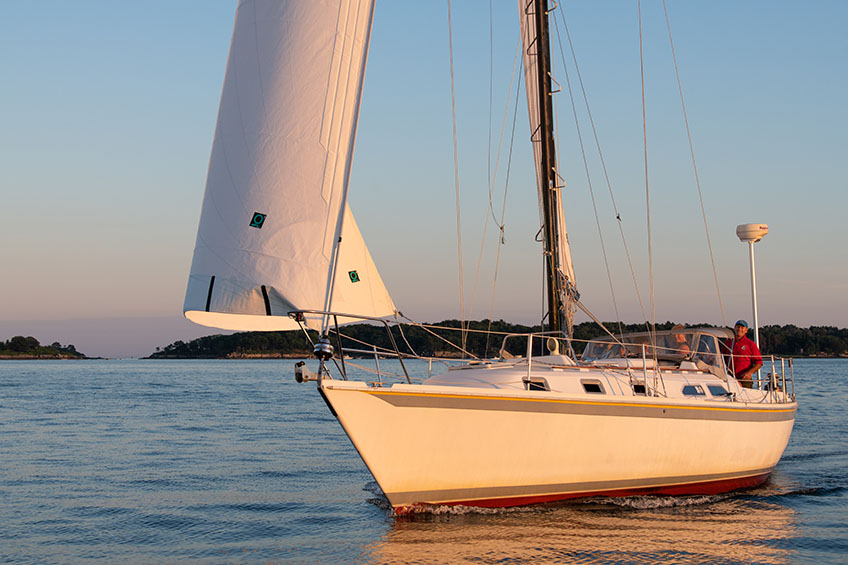
This column is usually dedicated to the arcane matters that captivate racing sailors. Riveting subjects like mainsail twist, mast bend, rig tuning, or my wife’s personal favorite, “headstay sag.” Sure to cause a listener’s eyes to glaze over. We are easily amused. I thought it would be a good time to pass on some techniques that racing sailors take for granted that will make a cruising sailor’s life more fun. Racing sailboats forces you to become a better sailor. You can get away with a lot as a cruiser. Try these tips and you will feel more comfortable and get more out of your time on the water.
The sails steer the boat
Anyone who has sailed a small boat has had this lesson pounded in the hard way. Try to bear off in any kind of breeze in a dinghy without easing the sails, and you probably end up swimming. If you have only grown up sailing bigger cruising boats, you can use the big rudder and righting moment to simply overpower the sails. Of course, as it gets windy, this equation changes. Suddenly the sails are much bigger than the rudder. Your cruising boat becomes at the mercy of the sails as if it were a dinghy. To bear off you need to ease the sheets generously. Whatever it takes to reduce heel and unload the helm. Ideally when you head up, you want to let the sails do the work, trimming as you go. Though you can let the luffing of the sails make them easier to pull in.
Upwind trim
The basic concept when trying to sail upwind is to sheet the sails in hard so that you can sail the closest angle to the wind possible. But there are limits. First, you can’t sheet as hard in lighter winds or whenever the boat is slow for that matter. The boat needs to move through the water for the keel to work. If you over-trim, you will never get going. Start eased a bit. Gradually trim once you get up to speed. Remember the golden rule: “speed first; then pointing.” This also means you can’t pinch (try to cheat and sail extra high) in light to moderate conditions. You may want to get to that upwind destination, but you just can’t force it. Make sure the headsail telltales are streaming aft and use them to guide your steering.
Conversely, as it gets windy, you can shift from the telltales to the boat’s angle of heel. Once up to speed you can trim hard and maintain a constant angle of heel. Don’t fight the helm. Let the boat coast up in the puffs to keep it on its feet in the puffs. Let the telltales lift on the inside or even carry a tiny bit of luff. Bear off in the lulls. This technique is called “feathering.”
Reaching trim
Don’t over-trim! The most common mistake is to have the sails pulled in too far. Remember the first thing they drilled in when you were learning. “Let it out until it luffs. Bring in just enough to stop.” Pulling the sails in does not create power. It simply makes them stall. It also makes the sail forces go sideways and less in line with where you want the boat to go. You will be surprised about how far out they can go. Long before you are dead downwind the mainsail can probably be all the way out. For headsails, one of the most simple, powerful tools is to set up a reaching lead on the rail or as far outboard as you can go. Use a second sheet. This allows the lead to pull down properly so that the top of the sail doesn’t open up and luff (twist). It also creates space so you can ease the mainsail further without luffing. Lead position for reaching will be slightly forward of normal upwind setting.
Halyard tension
On a cruising boat we may not have all the cool tools to help adjust and refine trim, but some are common to all. I have been on hundreds of boats to do sail checks for new cruising sails, and one thing constantly astounds me. On the vast majority I find the halyards neatly coiled and tied off at the mast; where they have been since the sail was first hoisted or put on the furling system. Halyard tension has never been adjusted for sailing conditions. Unfortunately, one size does not fit all. Halyard tension (luff tension) needs to change as a function of apparent wind velocity. No matter what you make a sail out of there is going to be stretch in both the sail and the halyard.
The great thing is that it is simple to get right. This is not like tuning a violin. Look up at the luff and ease the halyard until you have wrinkles beginning to emanate perpendicular to the luff. Then, take up just enough tension to smooth them out. Since amount of tension required is a function of apparent wind velocity, you will probably need to make a change based on point of sail. Upwind higher apparent wind will require more tension. You can ease off when reaching and running. Keep the active halyard on a winch for easy adjustment. If adding tension, let the sail luff so that you do not have to fight it. Maintaining proper luff tension will help power up the boat in light air and de-power as it gets windier.
Just point and go right? It’s not that simple. In light air (under 10 knots) you will have little or no apparent wind to fill the sails if you try to go anywhere close to dead downwind. You need to head up to generate apparent wind velocity. This means tacking downwind as opposed to going straight. You will sail more distance but at a much faster (and more pleasant) rate. The basic rule is to head up far enough to create pressure and fill the sails. Fall off too far, and the clew will drop. You need to strike a balance, sailing as low as possible while maintaining a full sail.
Obviously, the type of sail you have up will make a big difference. This is where asymmetric spinnakers are the right tool for the job. Bigger, lighter, and more powerful than any upwind headsail, they are made for tacking downwind and will allow you to sail much broader angles in less wind. Once the wind builds to 10-12 knots, you will create enough apparent wind to sail more directly downwind. At this point, poling out an upwind headsail with a whisker pole becomes a good option, though an asymmetrical will still work well.
This content was originally published on SpinSheet .
The Discussion

Us, too. We pour that passion into each of our newsletters to help you enjoy sailing even more.
- AROUND THE SAILING WORLD
- BOAT OF THE YEAR
- Email Newsletters
- Best Marine Electronics & Technology
- America’s Cup
- St. Petersburg
- Caribbean Championship
- Boating Safety
Sailboat Racing Tips: Second-Beat Strategy
- By Dave Reed
- August 16, 2022
- More: how to , Racing , Sailboat Racing , sailboat racing tips
- More How To
Why S-Turns, Roll Jibes and Roll Tacks Are Fast
The path to consistent boatspeed, headsail trim tips for floating leads, how clouds impact your race strategy, rib charter made easy, one charismatic crew, melges 24 team wins midwinter championship and overall title in st. pete, st. pete to shine again.
- Digital Edition
- Customer Service
- Privacy Policy
- Terms of Use
- Cruising World
- Florida Travel + Life
- Sailing World
- Salt Water Sportsman
- Sport Fishing
- Wakeboarding
Many products featured on this site were editorially chosen. Sailing World may receive financial compensation for products purchased through this site.
Copyright © 2024 Sailing World. A Bonnier LLC Company . All rights reserved. Reproduction in whole or in part without permission is prohibited.

IMAGES
VIDEO
COMMENTS
Here are eight tips for the first time sailboat racer that will make the challenge a bit more manageable and a little less daunting: Choose the right race. Ask around and pick a race that's not ultra competitive. There are always races that are more mellow than others. Choose one that is centered around fun, maybe a benefit regatta or a ...
Trim your sails to perfection. The maximum draft of all sails should be about 40 percent of the way aft of the leading edge. Sight up the mainsail's boom — the top batten should be parallel to the boom. Try to set the leech of the jib to be in line with the curvature of the mainsail.
Here are 10 tips for racing your cruiser, with an eye toward minimizing the learning curve and maximizing the fun. 1. Choose Wisely. Regattas come in all flavors, sizes and styles, allowing racers to choose events based on their skills, confidence and experience. Generally speaking, basic regattas are the place to start.
Tactics and boatspeed are one thing, but you still need a reasoned overall strategy before starting any race. Tactics are the decisions we make to execute our strategy. It's OK to sacrifice the ...
Sailboat Racing Tips: Rules at the Start. Sailing World Racing Editor Mike Ingham explores the rules to know for a clean start. By MIke Ingham. March 7, 2022. More: How-To, racing rules of sailing ...
On the practice day at the Helly Hansen Sailing World Regatta Series St. Petersburg we mic-up world champion Willem Van Waay and Olympian Stephanie Roble to ...
5 tips - Essential yacht racing skills. There are places to be gained on every corner of the race course. In our 5 tips collection, we asked top yacht racers to give us their hard-won advice on ...
Sail your boat and hit the line on time and at full speed. BONUS item: Clear Air. To sail full speed you need to be in clear air - clear of crowds. But wait - there's more: Surprisingly, for an upwind start - and most starts are upwind - you should position yourself so there is plenty of room to leeward, under your jib.
In conclusion, sailboat racing is a thrilling pursuit that combines the joys of sailing with the excitement of competition. Whether you're a novice or a seasoned sailor, following these tips and strategies will enhance your racing experience. So, hoist your sails, embrace the wind, and embark on an unforgettable journey of sailboat racing!
Sailboat Racing Starts Done Right. The building blocks of a good start are understanding the line setup, how quickly you approach, and making sure you're at full speed. By Greg Fisher. Updated ...
5. In close races, vital seconds can be gained by luffing head to wind (or dialling down on a downwind finish) right at the finish line. Upwind you close the line at about 1.3 times faster head to ...
Sailing World's Racing Editors share their expert tips, tricks, advice and how-to on the fundamentals of boatspeed, tactics strategy and rules of sailboat ra...
Downwind, jibe when lifted away from the mark and sail on the headers, guiding you in the right direction. Sailboat racing tactics are the culmination of strategic planning, meticulous execution, and adaptability to the ever-changing elements. By mastering the art of strategy and tactical maneuvers, sailors can elevate their racing performance.
by Kim Couranz - published on SpinSheet. The overall objective in sailboat racing is to cross the finish line first—to sail the course faster than your competitors. While there are endless decisions to make toward achieving that goal, simply sailing fast is a (and sometimes, the) primary key to success. Sailboat racing is also supposed to ...
Successful Racing Sailors Share Their Strategies for Overnight Races. "Everything becomes more complicated at night," says Tim Lyons, sailboat racing skipper of the Corsair 43 trimaran Triple Threat. "Even simple, routine tasks have a tendency to go afoul. This is where practice and repetition are crucial.
Sailing World Racing Editor Mike Ingham provides the essential tips for symmetric spinnaker trimming and expert advice for new spinnaker trimmers on how to m...
Sailboat racing has enough uncontrollable variables in the best of conditions. The lighter the breeze the greater the number of variables, most of which are out of control. Be prepared for having the breeze die just after you have established an unassailable lead while you watch the whole fleet sail up to you.
Sail down the line in either direction, lining up bow and stern with the line flags or buoys. Compare the bearing to a square line. A square line will be the average wind minus 90° when sailing on starboard, or the average wind plus 90° when sailing on port. Example: Your compass bearing when sailing the line on starboard toward the pin is 85°.
Racing sailboats forces you to become a better sailor. You can get away with a lot as a cruiser. Try these tips and you will feel more comfortable and get more out of your time on the water. The sails steer the boat. Anyone who has sailed a small boat has had this lesson pounded in the hard way.
The simple answer would be both, says Racing Editor Mike Ingham in the latest episode of Sailboat Racing Tips. But there are times when pressure takes precedent, and Ingham has the data to prove it.
Sailing World Racing Editor Mike Ingham explores tips, strategies and techniques for racing in light winds on inland waters, with lessons that apply for ocea...
Sailing World Racing Editor Mike Ingham lays the essentials for bringing a new jib trimmer onboard and how to establish repeatable marks and setting and esta...
Sailboat Racing Tips: Second-Beat Strategy. Sailing World Racing Editor Mike Ingham explains how to develop a second-beat strategy before rounding the leeward mark or gate. By Dave Reed. August 16 ...